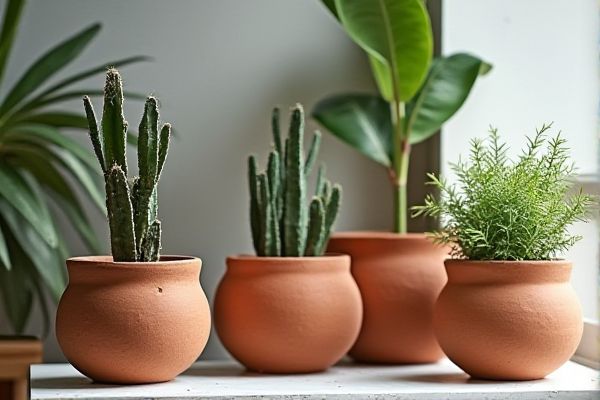
Ceramic pots offer a glazed finish that enhances moisture retention and aesthetic appeal, while terracotta pots are porous, promoting natural airflow and evaporation for healthier root systems. Discover the key differences and benefits of each to determine which pot best suits Your gardening needs by reading the rest of the article.
Table of Comparison
| Feature | Ceramic Pots | Terracotta Pots |
|---|---|---|
| Material | Glazed or unglazed clay, fired at high temperatures | Unglazed natural clay, porous and breathable |
| Porosity | Low (glazed), water-resistant | High, absorbs moisture easily |
| Durability | More durable, resistant to cracking and chipping | Fragile, prone to cracking in freezing temperatures |
| Weight | Heavier due to glazing and firing process | Lighter and easier to move |
| Aesthetic | Glossy finish, available in multiple colors | Matte, earthy orange-brown natural look |
| Water Retention | Better water retention, reduces watering frequency | Dries out faster, requires more frequent watering |
| Ideal Use | Indoor plants, decorative settings | Outdoor plants, gardens, succulents |
| Price | Generally more expensive | More affordable and widely available |
Introduction to Ceramic and Terracotta Pots
Ceramic pots are crafted from clay that has been fired at high temperatures, resulting in a durable, glazed surface that offers water resistance and a variety of decorative finishes. Terracotta pots, made from natural, porous clay fired at lower temperatures, are unglazed, allowing for excellent breathability and moisture evaporation, which benefits root aeration. Both options provide distinct advantages in gardening, with ceramic pots favoring aesthetic versatility and terracotta pots excelling in plant health through superior air and water permeability.
Material Composition: Ceramic vs Terracotta
Ceramic pots are crafted from refined clay mixed with minerals and fired at higher temperatures, resulting in a dense, glazed surface that enhances durability and water retention. Terracotta pots consist of natural clay fired at lower temperatures, producing a porous, unglazed texture that allows for better aeration and moisture evaporation. The material composition influences factors such as weight, breathability, and suitability for specific plants, with ceramic offering a smoother finish and terracotta providing a classic, earthy aesthetic.
Visual Appeal and Design Options
Ceramic pots offer a wide variety of vibrant colors and intricate glazed finishes that enhance your indoor or outdoor decor, while terracotta pots provide a classic, earthy look with their natural reddish-brown hue and porous texture. The non-porous surface of ceramic pots preserves moisture better, allowing for elaborate painted designs and glossy finishes that terracotta cannot achieve. Your choice depends on whether you prefer the sleek, artistic appeal of ceramic or the rustic, handmade charm of terracotta pots.
Durability and Longevity Comparison
Ceramic pots typically offer greater durability and longer lifespan than terracotta pots due to their glazed finish, which makes them more resistant to moisture and cracking. Terracotta pots, while aesthetically rustic and breathable for plant roots, tend to be more porous and can degrade faster when exposed to harsh weather conditions or repeated wetting and drying cycles. Your choice between these materials should consider the pot's exposure to elements and how long you expect it to last in your garden or indoor space.
Breathability and Plant Health
Ceramic pots offer less breathability compared to terracotta pots, which are porous and allow better air and moisture exchange, promoting healthier root systems. Terracotta's natural ventilation helps prevent root rot by reducing excess moisture, making it ideal for plants requiring well-drained soil. Your plants benefit from terracotta pots' breathable qualities, fostering a thriving environment through optimal aeration and moisture control.
Water Retention and Drainage Capabilities
Ceramic pots generally offer better water retention due to their glazed surfaces, which prevent moisture from escaping, making them ideal for plants that require consistent hydration. Terracotta pots, being porous, allow for excellent drainage and air circulation, helping to prevent root rot by drying out more quickly. Your choice should depend on your plant's water needs: use ceramic pots for moisture-loving plants and terracotta pots for those that prefer well-drained soil.
Suitability for Indoor and Outdoor Use
Ceramic pots offer excellent versatility, making them suitable for both indoor and outdoor use due to their glazed surfaces that resist moisture and prevent soil evaporation. Terracotta pots, made from porous clay, are ideal for outdoor plants as they allow air and moisture to pass through, enhancing root health but they may crack in freezing temperatures if used outdoors. For your indoor plants, ceramic pots are preferable because their sealed surfaces help retain moisture and prevent damage to indoor surfaces.
Weight, Portability, and Handling
Ceramic pots are generally heavier and less portable than terracotta pots due to their dense material and glazed surfaces, making them more durable but harder to move. Terracotta pots are lighter, porous, and easier to handle, providing better airflow for plant roots but requiring careful handling to avoid cracks. Your choice depends on balancing the ease of portability with the durability and breathability needed for your plants.
Cost-Effectiveness and Maintenance
Ceramic pots generally cost more upfront but offer better durability and resistance to weathering, reducing long-term replacement expenses. Terracotta pots are more affordable initially but require frequent maintenance due to their porous nature, which can lead to cracking and chipping over time. Choosing ceramic pots can be more cost-effective in the long run, especially for outdoor gardening where durability is crucial.
Choosing the Right Pot for Your Plants
Ceramic pots offer a glazed, non-porous surface that retains moisture longer, making them ideal for moisture-loving plants such as ferns and peace lilies. Terracotta pots, made from porous clay, promote air circulation and improve drainage, benefiting succulents and cacti by preventing root rot. Selecting the right pot depends on your plant's water needs, with ceramic pots suited for high-humidity environments and terracotta pots optimal for plants requiring dry soil conditions.
 homyna.com
homyna.com